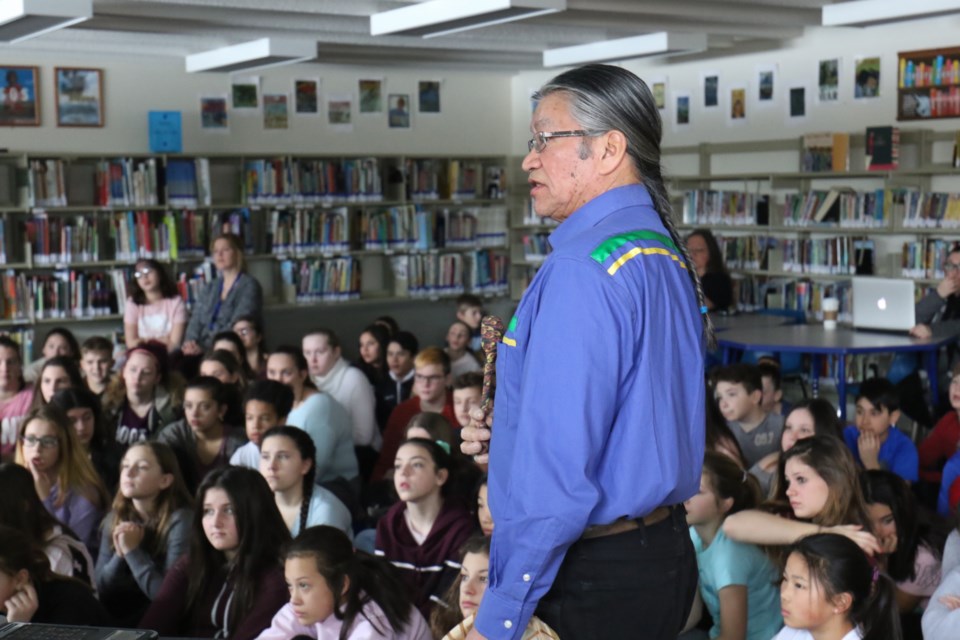(Editor's note: Due to some graphic material, reader discretion is advised)
Edmund Metatawabin, a survivor of the St. Anne’s Residential School in Fort Albany, Ont., spoke to students at St. Mary’s French Immersion School on Tuesday.
Metatawabin was already well known to many students at the school, as his experience at residential school was chronicled in a class project, where students were asked to make a graphic novel based on their research of the residential school system.
St. Mary’s teacher Anick Champagne-Hickey, who helped launch the graphic novel project, says that many of her students chose Metatawabin’s story as the basis for their graphic novels.
“When we saw their work, we knew that we couldn’t just put it on the shelf and let it go,” Champagne-Hickey said.
Then, a few weeks ago, Champagne-Hickey decided to touch base with Metatawabin personally.
“I found him on Facebook, so I reached out, sent him a message, and within a few hours he sent me his phone number and we talked,” she said.
Metatawbin says that he’s amazed by the graphic novel project on residential schools by students at St. Mary’s.
“I’m really proud of the school and amazed of the children, of the knowledge and understanding that they have,” he said. “I see their work, and it’s very moving.”
After students took their seats on the classroom floor Wednesday morning, Metatawabin shared a bit of himself with them - singing, hand drumming and showing the group pictures of his home on the James Bay coast.
Metatawabin was then asked to talk about his experience at residential school.
“When they think you’re old enough to go, you go,” Metatawabin told the students. “You have no choice.”
Metatawabin, who spent a total of eight years at the residential school, explained to students and teachers that Indigenous people were routinely denied trapping permits and access to the Hudson’s Bay Store if they didn’t allow their children to be placed in St. Anne’s.
He was just six years old when he first went to the school, and even at that age, he knew that he was stepping into a different world. Within his first two minutes at the school, he was slapped so hard that he fell against a wall.
"That was only the beginning,” Metatawabin said. “As a child, you know now there’s going to be no more singing, no more playing, no more laughing.”
He then went on to describe, in graphic detail, how he and other students at St. Anne’s were punished. Metatawabin said that an electric chair was introduced to the residential school in the 1940s, and that it was still there when he attended in the 1960s. He recalls being electrocuted in that chair twice.
Metatawabin also described the strap, how it was a handle with leather strings attached - at the end of those strings, pieces of metal. He said that he used to watch other children getting strapped at the school, hearing them scream as they were punished in front of their peers.
“They put them in the middle of us and we’re all watching,” he said. “What was their crime? Just being children.”
Gasps could be heard from students throughout the room as he spoke.
“The beds are this high, about 30 inches,” Metatawabin said. “You put your face down on that, and they pull your pants down, and they will hit like this.”
“One, two...and up to 20. You only feel the first one, just the first one, because the brain wants to protect your body.”
Students, transfixed on Metatawabin, were visibly shocked as he continued.
“You get sick, you vomit or you throw up in your bowl? They don’t throw that away, they make you eat it,” he said matter-of-factly. “Yes, they make you eat it, and there’s nobody to protect you.”
“You can’t tell your mother, you can’t tell your moshum [grandfather], you can’t tell the police. The police are helping them.”
These experiences in St. Anne’s resonated with St. Mary’s student Ronan Provenzano, who created a graphic novel about Metatawabin entitled Edmund while in Champagne-Hickey's class.
The 14-year-old said that he knew very little about the residential school system before researching Metatawabin’s experience.
“It was very hard, because it was really sad, and it kind of made me angry because everyone thought what they were doing was right, and it really wasn’t,” Provenzano said.
Provenzano was able to meet with Metatawabin the day before Wednesday’s event.
“It’s really cool, because for a really long time I looked up to him, and then when he was finally here, it was really awesome to meet him,” said Provenzano.
“I just said, ‘sorry that you had to go through that.’”
Staff present for the meeting between Metatawabin and Provenzano were, by all accounts, taken aback.
“For the first time I saw reconciliation happening,” said Champagne-Hickey. “He [Provenzano] felt a sincere need to tell Edmund that he’s sorry about what happened, and he told him that if he had been around during that time, he would never have let those things happen.”
Meanwhile, shortly before students entered the classroom to hear him speak, Metatawabin says that while older generations often have set ideas, the younger people are beginning to exhibit an understanding of the impact of residential school on its survivors, as evidenced by the St. Mary’s graphic novel project.
“It’s very clean, it’s very pure. I’m amazed by it, it’s good work,” he said.
“The government won’t do it, the adults won’t do it. Any people in authority that should be doing this is not doing this.”
